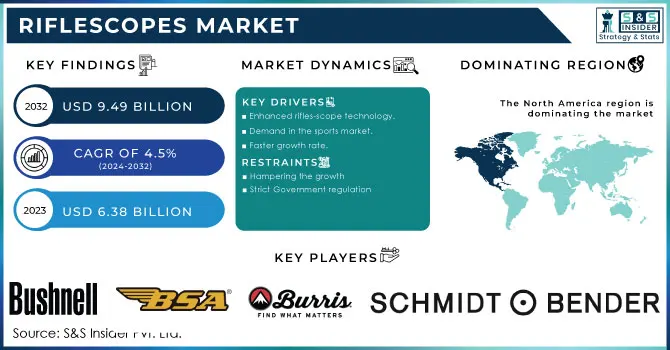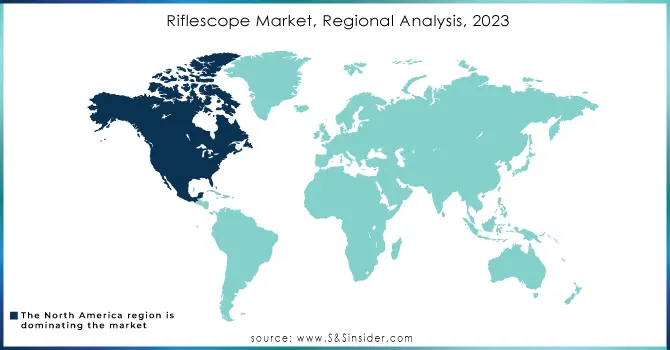Riflescopes Market Key Insights:

To get more information on Riflescopes Market - Request Sample Report
The Riflescopes Market size was valued at USD 6.38 billion in 2023 and is expected to reach USD 9.49 billion by 2032 and grow at a CAGR of 4.5% over the forecast period of 2024-2032.
The protection and security of the military is a matter of global concern. Increased awareness of the protection of military invaders varies around the world because world peace is in their hands. These key factors are rising markets related to the military arena. All markets for military equipment and equipment receive a lot of attention and opportunities from government institutions. Riflescope Market is one of the markets related to security services. The above factors also drive the growth of the Riflescope market due to its military needs. A riflescope is defined as a telescopic view on the rifle. It is usually attached to the top of the gun to indicate the target. A riflescope works like a telescope to direct something with its provided lens. It helps military snipers to target an object and attack it. As a result of this benefit, Riflescope Market is gaining widespread popularity in the global defense industry. Riflescopes are advanced features; they contain a variety of structures such as magnification, viewing space, vertical lens width, and other important structures that influence the Riflescope market. These features and structures assist the military in various military operations and equipment while directing their opponents and their attacks. Therefore, because of these factors, the Riflescope Market is rising sharply. The growing demand for identification capabilities developed by the military, especially snipers, is improving the Riflescope Market.
MARKET DYNAMICS
KEY DRIVERS
-
Enhanced rifles-scope technology.
-
Demand in the sports market.
-
Faster growth rate.
RESTRAINTS
-
Hampering the growth
-
Strict Government regulation
OPPORTUNITIES
-
Military modernization programs
-
Global demand.
CHALLENGES
-
High cost.
-
Low cost scopes.
THE IMPACT OF COVID-19
The COVID-19 pandemic has had a multifaceted impact on global economies. The global manufacturing of optical lenses, sensors, and components, as well as their assembly lines, has suffered moderately.
The supply of riflescopes for military usages is critical however, because these instruments are not replaced or changed on a regular basis due to their increasing durability, the market for them is not adversely affected. Resuming riflescope manufacturing and deliveries is dependent on a country's level of COVID-19 exposure, the level at which manufacturing operations are running, import-export regulations, and other factors. Although businesses may still accept orders, delivery schedules may not be fixed. The COVID-19 pandemic has had a negative impact on various market sectors. It faced difficult situations as a result of significant revenue losses. However, the pandemic period had a moderate impact on the Riflescope Market because riflescopes were critical in military forces. Because of the rise in terrorist attacks, the supply of these products was a top priority. However, the manufacturing operation and production process were halted due to the lockdown effect. Still, it quickly resumed after the global pandemic began to fade—the Riflescope Market Value to achieve its estimated growth rate in the coming years.
By Range
In terms of range, the Riflescope Market is divided into three categories: short-range, medium-range, and long-range. The short-range segment has dominated the market in recent years due to features such as rapid target acquisition, wide-field view, and lightweight. Medium-range riflescopes provide users with improved target acquisition and clearer vision to long-distance targets. Long ranges are commonly used by military forces. Due to increased terror attacks, the long-term segment exhibits a significant growth rate during the forecast period.
By Technology
The Riflescope Market is divided into three categories: EO/IR, thermal imaging, and laser. Because of their advanced optic capability, EO/IR riflescopes can hit the target with pinpoint accuracy. Thermal imaging provides enhanced surveillance, increased visibility, and alerts for false alarms. These features are driving the segment forward. Laser riflescopes are widely used in tactical missions due to features such as accurate targeting in low light.
By End-Use
During the forecast period, the defense segment is expected to grow rapidly. The increase is due to an increase in the defense budget, increased rifle procurement contracts, and military force expansion. Military forces are replacing traditional rifle scopes with advanced scopes, which is driving market growth. Due to rising demand for rifles for commercial applications such as hunting and sports shooting, the commercial segment is expected to grow significantly between 2022 and 2028.
COMPETITIVE LANDSCAPE
The riflescope market is highly fragmented, with several players accounting for significant amounts of shares in the market. Some of the prominent companies in the riflescope market are Burris Company, Hawke Optics, Hensoldt, Leupold & Stevens Inc., and Night force Optics. Several organizations have formed long-term relationships with the armed forces to upgrade and improve the battlefield capabilities of infantry soldiers. as well as for the development of future soldier modernization programs of defense ministries. Companies are investing heavily in R&D to develop new and advanced products and technologies that will give soldiers on the frontlines a tactical advantage over their competitors. Nikon introduced a new flagship hunting riflescope, Monarch riflescope, which is a long-range type riflescope that is best for hunting and sports activities. For military applications, manufacturers are introducing technologies, such as GPS geotagging, increased magnification, ultra HD magnification, along with connectivity features, such as Bluetooth and Wi-Fi, in the riflescope for connectivity with other gadgets, such as smart goggles for improvising accuracy Such developments are expected to assist companies in expanding their geographic presence by acquiring new contracts from the armed forces.
KEY MARKET SEGMENTATION
By Application
-
Armed forces
-
Hunting
-
Shooting sports
By Technology
-
EO/IR
-
Laser
By End_User
-
Defense
-
Commercial
By Function
-
Day sights,
-
Night sights
By Range
-
Short (50 to 100 yards)
-
Medium (100 to 500 yards)
-
Long (> 500 Yards)
Regional Analysis
The geographical status of the Riflescope Market Outlook depicts the market's development in various parts of the world, including North America, Europe, Asia Pacific, the Middle East, Africa, and Latin America. North America is the dominant region, and it will continue to be the largest regional market among other regions. The use of riflescopes in European countries boosts the Riflescope market's regional growth. Because of shooting sports and hunting in developed countries such as Japan, Australia, and South Korea, the Asia Pacific market experienced the highest CAGR value during the evaluation period. The Middle East and Africa, as well as Latin America, have seen consistent growth as a result of the use of rifles for security and military purposes.

Need any customization research on Riflescopes Market - Enquiry Now
REGIONAL COVERAGE:
North America
-
USA
-
Canada
-
Mexico
Europe
-
Germany
-
UK
-
France
-
Italy
-
Spain
-
The Netherlands
-
Rest of Europe
Asia-Pacific
-
Japan
-
South Korea
-
China
-
India
-
Australia
-
Rest of Asia-Pacific
The Middle East & Africa
-
Israel
-
UAE
-
South Africa
-
Rest of Middle East & Africa
Latin America
-
Brazil
-
Argentina
-
Rest of Latin America
KEY PLAYERS
The Key Players are Bushnell, BSA Optics, Burris Company, Schmidt-Bender, Walther Arms, INC, Hawke Optics, Nikon, Nightforce Optics, Hensoldt Sensors GmbH, Leupold & Stevens Inc & Other Players
| Report Attributes | Details |
|---|---|
| Market Size in 2023 | US$ 6.38 Billion |
| Market Size by 2032 | US$ 9.49 Billion |
| CAGR | CAGR of 4.5% From 2024 to 2032 |
| Base Year | 2022 |
| Forecast Period | 2024-2032 |
| Historical Data | 2020-2022 |
| Report Scope & Coverage | Market Size, Segments Analysis, Competitive Landscape, Regional Analysis, DROC & SWOT Analysis, Forecast Outlook |
| Key Segments | • By Application (armed forces, hunting, shooting sports) • By Technology (EO/IR, thermal imaging, laser) • By End User (Defense, Commercial) • By Function (Day sights, night sights) • By Range (Short (50 to 100 yards), Medium (100 to 500 yards), Long (> 500 Yards)) |
| Regional Analysis/Coverage | North America (USA, Canada, Mexico), Europe (Germany, UK, France, Italy, Spain, Netherlands, Rest of Europe), Asia-Pacific (Japan, South Korea, China, India, Australia, Rest of Asia-Pacific), The Middle East & Africa (Israel, UAE, South Africa, Rest of Middle East & Africa), Latin America (Brazil, Argentina, Rest of Latin America) |
| Company Profiles | Bushnell, BSA Optics, Burris Company, Schmidt-Bender, Walther Arms, INC, Hawke Optics, Nikon, Nightforce Optics, Hensoldt Sensors GmbH, Leupold & Stevens Inc |
| DRIVERS | • Enhanced rifles-scope technology. • Demand in the sports market. • Faster growth rate. |
| RESTRAINTS | • Hampering the growth • Strict Government regulation |

